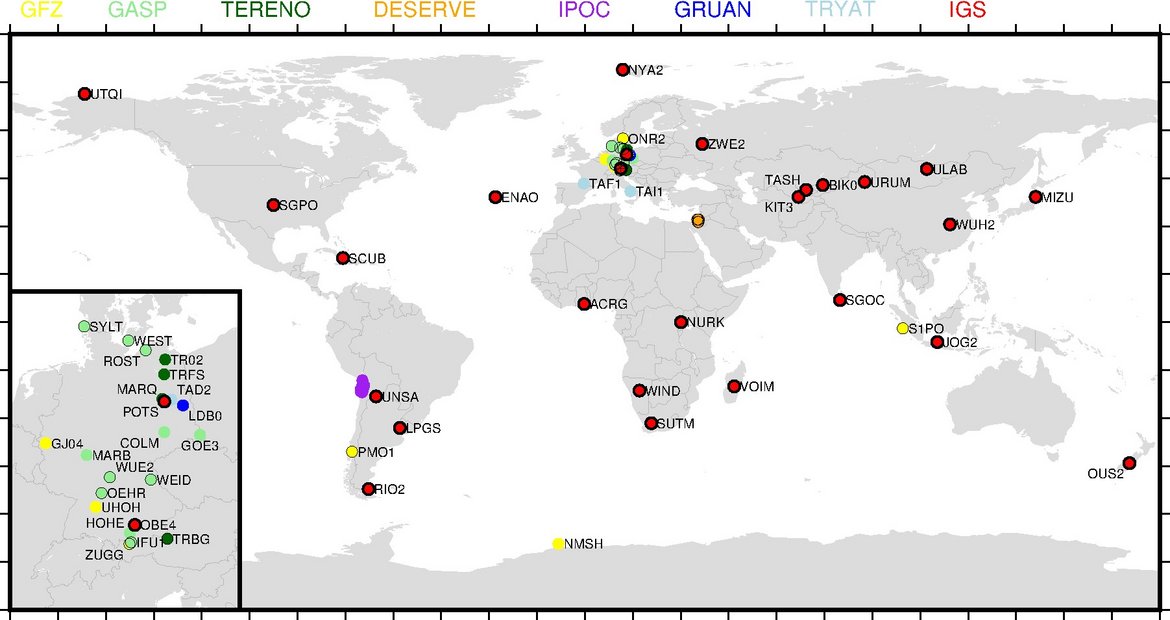GNSS Station Network
Contact:
Web:
Infrastructure belongs to:
Since the early 1990s, the GFZ has operated a global GNSS station network with currently about 70 stations for precise satellite clock & orbit determination, realization of the terrestrial reference frame, radio occultation measurements or studies on crust dynamics. A subset of these stations contributes also to the tracking networks of the International GNSS Service (IGS) and the EUREF Permanent GNSS Network (EPN). Other stations contribute to GFZ observatories (IPOC, DESERVE, TERENO), to the GPS Atmosphere Sounding Project (GASP), to WMO Global Climate Observing System Reference Upper-Air Network (GRUAN) or other external cooperations. Within the ISDC we offer data of 51 GFZ GNSS stations. All GFZ stations follow the site guidelines of the International GNSS Service.
For more details please visit the Information System and Data Center.
Categories
Data Types
Disciplinary Keywords
Instrumentation
Since the foundation of the GFZ, GPS / GNSS observations have been carried out in continuous operation as well as in campaign mode. At the beginning, standard notebooks or PCs were used for data handling, but soon the systems became more complex to ensure uninterrupted operation and to enable "self-healing" and remote maintenance.
Instruments
-
GSS (2007)
Based on a 19 "rack, this station type provides a cold redundancy of all hardware items except the actual sensors (GNSS receiver / weather station). It is a fanless, passively cooled system that has been tested in a climatic chamber at ambient temperatures of -20 to +40 ° C. It has a UPS which provides a power supply of at least 10 hours. The Internet connection is done via a VPN router for secure data transmission and remote management functions. The total current consumption depends on the hardware used and is about 40 to 80 watts. The GSS is the current default layout for use in the global GNSS reference network of the GFZ.
Follow-up model: tinyPC/4
-
tinyBlack (2020)
The tinyBlack is a robust, cost-effective unit for GNSS raw data recording. It consists of an industrial type single board Linux PC and cost effective or geodetic GNSS receiver (Javad, Septentrio, Swiftnav Piksi, uBlox) utilizing the signals from GPS, GLONASS, Galileo and BeiDou. In addition, it contains a 4 channel switching unit, allowing the power control of the internal GNSS receiver and the three power outlets.
The tinyBlack is suitable for the highly precise determination of coordinates (e.g., for monitoring dams or volcanoes), as a reference station (e.g. for drones) in post-processing and for determining the water vapor content of the atmosphere. Advanced models with an update rate of up to 50 Hz are available, e.g., for scintillation observation or as reference station receiver (CORS). In addition, a PC-only version without GNSS receiver is available too.
The development of the tinyBlack led to the spin-off maRam UG (haftungsbeschränkt), www.maram-ug.de, where it is continuously being improved and developed.
-
tinyPC (2009)
This hardware is based on a low power 3.5" single board computer with a 486 SX processor with 300 MHz (tinyPC). Soon this processor was replaced by a 486 DX processor with 800 MHz (internal designation: tinyPC/2), which allows more computing power with the same power consumption. An internal 4-channel switching unit was developed to monitor the connected devices (like telemetry, GNSS receiver, weather station) and to enable hard resets. So the tinyPC acts as a switchable power supply. The total power consumption is only 2.5 Watt. With an input voltage range of 8 to 18 VDC the tinyPC is ideal for solar power/fuel cell powered applications. There is also a version with an extended input voltage range from 8 to 36 VDC for integration into 24 VDC power supply networks.
All hardware elements are specified for ambient temperatures from -40 °C to +85 °C. This hardware is used for example in the Integrated Plate Boundary Observatory Chile IPOC, TERENO (Germany) and ZAIAG (Kyrgyzstan).
As operating system we use a standard Debian Linux distribution. The GNSS station software runs natively on the system.
Follow-up model: tinyBlack PC
-
tinyPC/3 (2012)
Developed on the basis of the tinyPC/2, this type includes a JAVAD OEM GNSS board. This GNSS receiver allows the recording of GPS, GLONASS and Galileo signals and was the most compact GNSS measuring system in section 1.1. It is still in use for campaign operation, but can also be used as a real-time reference station when the power consumption is a critical issue. The power consumption of the tinyPC / 3 type GNSS station is approximately 5 watts. This type is successfully used, e.g., at the Dead Sea and, together with the Alfred Wegener Institute, at Neumayer Station in Antarctica, surviving both, the hot arid as well as the harsh arctic conditions for almost 10 years.
Follow-up model: tinyBlack
-
tinyPC/4 (2017)
Our current standard reference station setup tinyPC/4 is an advancement of the tinyPC/3. In addition to an improved GNSS receiver (Javad TRE-3, Septentrio Asterx 4) for GPS / Glonass /Galileo / Beidou tracking, this type includes two redundant single-board computers and a GSM / WAN / VPN router for redundant data connection.
Links
Data Access via
Project Webpage
Relationships
- is related to
